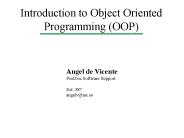Aspect-Oriented Programming in Smalltalk - PowerPoint PPT Presentation
Title:
Aspect-Oriented Programming in Smalltalk
Description:
Aspect-Oriented Programming in Smalltalk Kris Gybels Robert Hirschfeld Outline Introduction to AOP Using AOP for Smalltalk with ... AspectS Andrew Conclusion ... – PowerPoint PPT presentation
Number of Views:253
Avg rating:3.0/5.0
Title: Aspect-Oriented Programming in Smalltalk
1
Aspect-Oriented Programming in Smalltalk
- Kris Gybels
- Robert Hirschfeld
2
Outline
- Introduction to AOP
- Using AOP for Smalltalk with ...
- AspectS
- Andrew
- Conclusion
3
Introduction
4
Aspect-Oriented Programming
- Improve quality of softwareby introducing new
modularization mechanismsto deal with
cross-cutting concerns.
5
Software Engineering
- Break problems into relatively independent
smaller ones - Implement and compose subproblems as modules
- What we want
- Natural mapping between problems and modules
- Localization and separation of concerns
6
Why OOP?
- OOP excellent for modeling entities of problem
domain - Problem domain objects map naturally to
implementation objects - Example e-Library system
- Books -gt Book class
- Library clients -gt Client class
- Printers -gt Printer class
7
Why AOP?
- Example
- Concurrent processing concern?
- OO protect all objects with semaphores ...
- OOP problems when having to take into account
special aspects that cross-cut a system - Requires code
- In different places
- Not really related to modeling behavior from the
problem domain
8
Problems with cross-cutting concerns
- Concern implementation intertwined with
implementation of other concerns - Concern not localized
- Hurts code ...
- Readability
- Evolvability
- Maintainability
- ...
9
AOP Goals
- Modularize cross-cutting concerns
- Create language/system to express
- Points in a program where aspects influence the
program (joinpoints) - How the aspect influences the program there
10
Types of AOP languages
- High-level
- Special aspect-specific languages to express
aspects in (e.g. COOL)Method setTitle and
setYear on book objects cannot run
concurrently-gtcoordinator Book mutexclusive
setTitle, setYear
11
Types of AOP languages
- General purpose
- General purpose languages useable for different
aspects (e.g. AspectJ, AspectS, Andrew, )When
message setTitle is sent to a book object first
do a wait on the semaphore
12
Using AOP for Smalltalk
13
AspectS Andrew
- Both based on the AspectJ general-purpose
approach when ... before/after do ... - Joinpoints key events in the execution of an OO
program - Message sends
- Message receptions
- State updates/accesses
- Aspects influence advice
- Smalltalk code
14
AspectS vs Andrew
- AspectS
- Uses Smalltalk to express joinpoints
- Andrew
- Uses special language based on Logic Meta
Programming to express joinpoints
15
Using AOP for Smalltalk
- AspectS
16
Aspects in AspectS
- Implemented as subclasses of a specific class,
can have - regular variables
- regular methods
- special methods used to implement advice
for keeping and acting on state particular to the
aspect (e.g. Semaphores)
17
Writing advice example
- AsMorphicMousingAspectgtgtadviceMouseEnter
- AsBeforeAfterAdvice
- qualifier (AsAdviceQualifier attributes
receiverClassSpecific. ) - pointcut Morph allSubclasses
- select each
- each includesSelector mouseEnter
- thenCollect each AsJoinPointDescriptor
- targetClass each
- targetSelector mouseEnter
- beforeBlock receiver arguments aspect
client - self
- showHeader 'gtgtgt MouseENTER gtgtgt
- receiver receiver
- event arguments first
18
Pointcuts
- Blocks which compute a collection of
JoinpointDescriptors - JoinpointDescriptors indicate method execution
joinpoints the advice influences class
selector - The full Smalltalk meta system can be used!
19
Advice
- A Smalltalk block executed before or after every
joinpoint matching the pointcut - The block is passed context data of the joinpoint
- actual object that received the message
- arguments sent with the message
20
Tools
- No special support for defining and editing
aspects, just use system browsers - Browser extensions for showing the impact of
aspects
21
Tools
22
Tools
23
Tools
24
Using AOP for Smalltalk
- Andrew
25
Aspects in Andrew
- Similar to AspectS, implemented as subclasses of
a specific class - regular variables/methods
- advices
- logic predicates
- Uses logic meta programming to express pointcuts
26
Why logic pointcuts?
- Cross-cutting compute or describe?
- Computing allows flexible cross-cuts
- Cross-cutting is best kept descriptive
- Logic programming combines the two properties
27
Logic Meta Programming
- Meta programming for Smalltalk using logic
language SOUL - Smalltalk programs represented as logic facts
- class(?c)
- methodInClass(?c, ?selector, ?m)
- LiCoR extensive library of logic rules to reason
about Smalltalk programs
28
Logic cross-cutting
- Adds predicates to reify joinpoints
- reception(?jp, ?selector, ?args)
- send(?jp, ?selector, ?args)
- get(?jp, ?instVar, ?value)
- set(?jp, ?instVar newV, ?, ?oldV)
29
Writing advice ...
- before ?jp matching
- reception(?jp, name)
- do
- Transcript show name accessed through accessor
30
Code patterns cross-cutting
- LMP successfully used to detect patterns in code
- Smalltalk programming idioms
- Design patterns
- ...
- Can be used to ...
- Clearly capture the pattern underlying a
cross-cut - Specialize joinpoints (Open weaver)
31
Accessor example
- Use LMP to find accessors
- isAccessor(?class, ?selector, ?varName) if
- class(?class),
- methodNamed(?class, ?selector, ?method),
- statements(?method, ?statements),
- equals(?statements, ltreturn(variable(?varName))gt
)
32
Observer
- after ?jp matching
- reception(?jp, ?selector),
- withinClass(?jp, Person),
- notify(Person, ?selector, ?property),
- viewInterestedIn(?property)
- do
- views do view view changed ?property
asSymbol
33
Observer
- notify(Person, birthDate, birthDate).
- notify(Person, birthDate, age).
- notify(Person, name, name)
34
Observer
- viewInterestedIn(age).
- viewInterestedIn(name)
35
Using AOP for SmalltalkAspectS vs Andrew
- Pointcuts more familiar for a Smalltalk programmer
- Pointcuts require one to learn new language
36
Implementing AOP for Smalltalk
37
Final notes Conclusions
38
Conclusions
- AspectS vs Andrew
- AspectSs pointcuts more familiar to Smalltalk
programmer - Andrew pointcut language provides enhanced
readability extensive code reasoning library - AspectS Andrew vs AspectJ
- Use of full MOP allows one to find more code
patterns to cross-cut
39
Links
- prog.vub.ac.be/kgybels/andrew/
- www.prakinf.tu-ilmenau.de/hirsch/ Projects/Squea
k/AspectS - VisualWorks 7 distro
- www.aosd.net
- kris.gybels_at_vub.ac.be
- hirschfeld_at_acm.org































